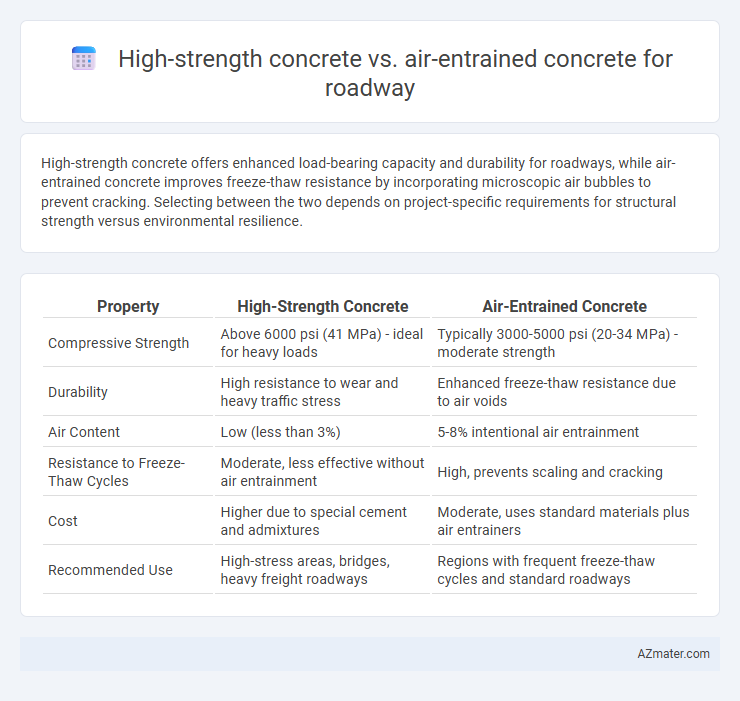High-strength concrete offers enhanced load-bearing capacity and durability for roadways, while air-entrained concrete improves freeze-thaw resistance by incorporating microscopic air bubbles to prevent cracking. Selecting between the two depends on project-specific requirements for structural strength versus environmental resilience.
Table of Comparison
| Property | High-Strength Concrete | Air-Entrained Concrete |
|---|---|---|
| Compressive Strength | Above 6000 psi (41 MPa) - ideal for heavy loads | Typically 3000-5000 psi (20-34 MPa) - moderate strength |
| Durability | High resistance to wear and heavy traffic stress | Enhanced freeze-thaw resistance due to air voids |
| Air Content | Low (less than 3%) | 5-8% intentional air entrainment |
| Resistance to Freeze-Thaw Cycles | Moderate, less effective without air entrainment | High, prevents scaling and cracking |
| Cost | Higher due to special cement and admixtures | Moderate, uses standard materials plus air entrainers |
| Recommended Use | High-stress areas, bridges, heavy freight roadways | Regions with frequent freeze-thaw cycles and standard roadways |
Introduction to High-strength and Air-entrained Concrete
High-strength concrete, characterized by compressive strength exceeding 6,000 psi, offers superior load-bearing capacity and durability for roadways subjected to heavy traffic and environmental stress. Air-entrained concrete incorporates microscopic air bubbles to enhance freeze-thaw resistance and reduce scaling caused by deicing chemicals, crucial for longevity in cold climates. Selecting between these concretes depends on specific performance requirements, including structural demands and environmental exposure conditions on road surfaces.
Key Properties of High-strength Concrete
High-strength concrete for roadways exhibits compressive strengths exceeding 6000 psi, delivering superior durability and load-bearing capacity compared to air-entrained concrete. Its low water-to-cement ratio and dense microstructure minimize permeability, enhancing resistance to freeze-thaw cycles and chemical attack. These properties result in extended pavement lifespan and reduced maintenance costs, making high-strength concrete ideal for heavy traffic and demanding environmental conditions.
Key Features of Air-entrained Concrete
Air-entrained concrete contains microscopic air bubbles that enhance its resistance to freeze-thaw cycles, making it ideal for roadways in cold climates. These air voids improve durability by preventing surface scaling and reducing internal pressure caused by water expansion during freezing. This concrete type also offers better workability and increased resistance to deicing chemicals compared to high-strength concrete, which primarily emphasizes compressive strength rather than freeze-thaw durability.
Applications in Roadway Construction
High-strength concrete is ideal for roadway construction requiring enhanced load-bearing capacity, such as bridges, overpasses, and heavily trafficked highways, due to its superior compressive strength and durability. Air-entrained concrete excels in freeze-thaw environments commonly found in colder climates by improving resistance to cracking and scaling through its microscopic air bubble system. Combining these concrete types optimizes longevity and performance in roadways exposed to heavy loads and harsh weather conditions.
Durability and Longevity Comparison
High-strength concrete offers superior compressive strength and is optimal for heavy load-bearing roadways, while air-entrained concrete excels in freeze-thaw resistance, enhancing durability in cold climates. The entrapped air bubbles in air-entrained concrete mitigate micro-cracking caused by freeze-thaw cycles, significantly extending pavement longevity. For long-term roadway performance, combining high-strength concrete with air-entrainment provides a balanced approach, maximizing both structural capacity and resistance to environmental deterioration.
Performance Under Extreme Weather Conditions
High-strength concrete offers superior load-bearing capacity and durability, making it ideal for roadways exposed to heavy traffic and high stress, while air-entrained concrete excels in resisting freeze-thaw cycles due to its microscopic air bubbles that prevent water expansion damage. Under extreme weather conditions, air-entrained concrete significantly reduces surface scaling and improves longevity in cold climates prone to frost, whereas high-strength concrete maintains structural integrity in hot and dry environments by resisting cracking and deformation. Selecting the appropriate concrete type depends on environmental challenges, with air-entrained concrete preferred for cold regions and high-strength concrete favored for areas subject to heavy mechanical loads and thermal stress.
Cost Analysis: High-strength vs Air-entrained Concrete
High-strength concrete typically incurs higher initial material costs due to specialized cementitious blends and admixtures designed to improve durability and load-bearing capacity in roadways. Air-entrained concrete, while generally less expensive upfront, offers cost savings in freeze-thaw durability and reduced maintenance in climates subject to frequent temperature fluctuations. Evaluating lifecycle costs reveals that high-strength concrete may provide better long-term economic benefits in high-traffic areas due to its superior compressive strength and reduced repair frequency, whereas air-entrained concrete is more cost-effective for roads in cold environments with moderate traffic.
Sustainability and Environmental Impact
High-strength concrete reduces material usage and extends pavement lifespan, significantly lowering carbon emissions associated with frequent repairs and reconstruction. Air-entrained concrete enhances durability by improving freeze-thaw resistance, reducing maintenance needs and environmental degradation caused by road surface damage. Both materials contribute to sustainable roadway construction by optimizing resource efficiency and minimizing the ecological footprint of transportation infrastructure.
Maintenance Requirements and Lifecycle Costs
High-strength concrete offers superior durability and load-bearing capacity, reducing the frequency of repairs and lowering maintenance requirements for roadways exposed to heavy traffic loads. Air-entrained concrete improves resistance to freeze-thaw cycles by incorporating microscopic air bubbles, which significantly decreases surface scaling and pothole formation, thereby extending pavement life in cold climates. While high-strength concrete often entails higher initial costs, its enhanced lifespan and reduced maintenance demands can lead to lower overall lifecycle costs compared to traditional air-entrained concrete, especially in environments with less severe freeze-thaw action.
Choosing the Right Concrete for Roadway Projects
High-strength concrete offers superior load-bearing capacity and durability essential for heavy traffic roads, while air-entrained concrete enhances freeze-thaw resistance and prevents surface scaling in colder climates. Selecting the right concrete for roadway projects requires evaluating environmental conditions, traffic loads, and maintenance expectations to balance performance and longevity. Integrating optimized mix designs improves the resilience and lifespan of pavements, ensuring safety and cost-efficiency.

Infographic: High-strength concrete vs Air-entrained concrete for Roadway
 azmater.com
azmater.com